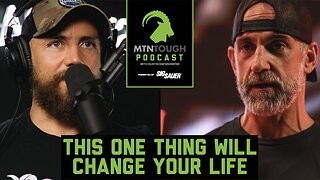Premium Only Content

A very important PCOS reminder for us all! We all have different eoot causes with PCOS
There are many different ways to track progress when trying to lose weight. Some common methods include:
Weighing yourself: This can be done using a scale at home or at a gym. It's important to try to weigh yourself at the same time each day, as weight can fluctuate throughout the day.
Measuring your waist circumference: Your waist circumference can be a good indicator of abdominal fat, which is associated with an increased risk of certain health problems. To measure your waist circumference, wrap a tape measure around your waist at your natural waistline (just above your hips).
Taking progress photos: Taking photos of yourself can be a helpful way to track your progress over time, especially if you're focusing on body composition changes rather than just weight loss.
Tracking your diet and exercise: Keeping a food diary or using a nutrition tracking app can help you stay on track with your diet and make sure you're getting the nutrients you need. Similarly, tracking your workouts can help you see how much exercise you're doing and where you can improve.
Checking your body fat percentage: There are several ways to measure body fat percentage, including skinfold calipers, bioelectrical impedance analysis (BIA), and dual-energy x-ray absorptiometry (DXA). These methods can give you a more accurate picture of your body composition and how much fat you've lost.
Remember, it's important to be patient and consistent when trying to lose weight. Weight loss can take time, and it's important to focus on making healthy lifestyle changes rather than trying to achieve rapid weight loss.
Body transformation photos can be a powerful way to document and celebrate your progress as you work towards your health and fitness goals. These photos can help you see the changes in your body over time, which can be especially motivating when you're trying to lose weight or build muscle.
There are a few tips you can follow to help you take good transformation photos:
Find a consistent background: Using the same background for your photos can help you see the changes in your body more clearly.
Wear the same clothes: Wearing the same clothes (or similar clothes) in each photo can help you see the changes in your body more accurately.
Use the same lighting: Using the same lighting can help ensure that your photos are consistent and that you can see the changes in your body clearly.
Take photos from the same angles: Taking photos from the same angles can help you see the changes in your body more easily.
Take photos at regular intervals: Taking photos at regular intervals (e.g., every week or every month) can help you see your progress over time.
Remember to be patient and consistent when trying to make changes to your body. It can take time to see the results of your efforts, and it's important to focus on making healthy lifestyle changes rather than trying to achieve rapid transformation.
It's important to keep in mind that weight is just one factor to consider when it comes to health and wellness. It's not uncommon for people to see fluctuations in their weight due to factors such as water retention, muscle gain, and changes in diet and exercise.
If you're trying to lose weight, it's important to focus on making healthy lifestyle changes rather than trying to achieve rapid weight loss. This can include things like eating a balanced diet, getting regular physical activity, and managing stress.
It's also important to remember that weight loss can take time, and it's normal for progress to be slower at certain times. It's important to be patient and consistent, and to focus on making healthy lifestyle changes that you can sustain over the long term.
If you're concerned about your weight or are having trouble losing weight, it can be helpful to speak with a healthcare professional or a registered dietitian. They can help you develop a healthy weight loss plan that is right for you.
-
 1:58:10
1:58:10
Robert Gouveia
18 hours agoMatt Gaetz REJECTS Report, Sues Committee; Luigi Fan Club Arrives; Biden Commutes; Festivus Waste
219K175 -
 1:31:40
1:31:40
Adam Does Movies
18 hours agoThe Best & Worst Christmas Movies! - LIVE!
6362 -
 58:10
58:10
Kimberly Guilfoyle
20 hours agoAmerica is Back & The Future is Bright: A Year in Review | Ep. 183
118K64 -
 3:03:27
3:03:27
vivafrei
1 day agoEp. 242: Barnes is BACK AGAIN! Trump, Fani, J6, RFK, Chip Roy, USS Liberty AND MORE! Viva & Barnes
208K213 -
 LIVE
LIVE
2 MIKES LIVE
1 hour agoTHE MIKE SCHWARTZ SHOW with DR. MICHAEL J SCHWARTZ 12-24-2024
111 watching -
 1:14:17
1:14:17
MTNTOUGH Fitness Lab
22 hours agoNavy SEAL Dom Raso: The Cold, Hard Truth About Modern Brotherhood | MTNPOD #96
241 -
 43:42
43:42
Dad Dojo Podcast
17 hours agoEP14: Every Girl Dad's Biggest Fear and How To Prevent It
4 -
 55:06
55:06
Bek Lover Podcast
10 hours agoWill Trump Pull Off A Miracle? Other Strange News Podcast...
811 -
 55:53
55:53
PMG
22 hours ago $0.01 earned"Hannah Faulkner and Courtney Reed | BEHIND THE LENS OF A TRUMP PHOTOGRAPHER"
277 -
 8:09:50
8:09:50
Dr Disrespect
23 hours ago🔴LIVE - DR DISRESPECT - MARVEL RIVALS - GOLD VANGUARD
215K35